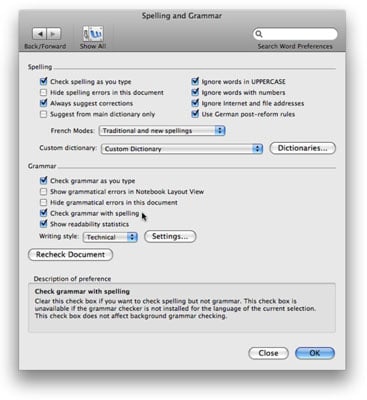
The language you set here is what Word will use to refer to when checking for your spelling. The first section here is called “Choose Editing Languages.” This section is where you can choose the language that Microsoft Word will use to go over your documents. Therefore, you have to go to the Word Options window and then to the Language tab. Under Proofing, you can look for the grammar check options, but that doesn’t determine the language. You can open an existing document or create a new one. Easily Switch Between American and British Spellcheck
Find hide spelling errors for this documents only in microsoft word for mac 2011 how to#
This can be difficult if you’re writing in Microsoft Word because the application can’t distinguish between American English and British English, especially when the former is the default.ĭon’t start fretting just yet, however, because in this tutorial, we’ll show you how to switch between American and British spellcheck in Word. The problem when writing for both audiences, however, is that you have to adapt. Here is a quick tip on how to switch between American and British Spell-Check in Word. For example, in British English, behavior is spelled with a “u” while in American English, it is spelled as “behavior.” The same goes for “color” in American English, and “colour” in British English and many other words. So as a writer who may be writing for American and British audience groups, it’s best to know which spelling to use. The spellings are strikingly different between the two. Have questions or feedback about Office VBA or this documentation? Please see Office VBA support and feedback for guidance about the ways you can receive support and provide feedback.American English is so much different from British English. If the Document Inspector encounters errors during the operation, the module is flagged, displays an error message, and the data for that module does not change. If you choose to remove the data for a given module, the dialog box displays descriptive text that indicates whether the operation was successful or not. If the module does not find data, the dialog box displays a message to that effect. If a given module finds data, the dialog box includes a Remove All button that you can click to remove that data. Use the Document Inspector dialog box to select the type or types of data to find in the document.Īfter the modules complete the inspection, the Document Inspector displays the results for each module in a dialog box.

The Document Inspector has modules that help users inspect and fix specific elements of a given document. The Document Inspector in Word, Excel, and PowerPoint includes the following enhancements.

We recommend that you run the Document Inspector before you sign a document or invoke IRM on a document.Īs a developer, you can use the Document Inspector framework to extend the built-in modules and integrate your extensions into the standard user interface.


Microsoft does not support the automatic removal of hidden information for signed or protected documents, or for documents that use Information Rights Management (IRM).


 0 kommentar(er)
0 kommentar(er)
